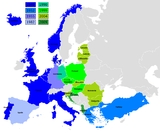
1957 Paris summit
Encyclopedia
The 1957 Paris summit was the first NATO summit
bringing the leaders of member nations together at the same time. The formal sessions and informal meetings in Paris
, France
took place on December 16-19, 1957. This was only the second meeting of the NATO heads of state following the ceremonial signing of the North Atlantic Treaty
on April 4, 1949.
and others labeled as a crucial "crossroads" in their relationship. The summit was designed as "a reconsideration of the relationship of the strategy for the defense of Western Europe", particularly in light of fading US nuclear superiority with regard to the Soviet Union. The summit was considered to be the main American diplomatic response to the Russian launch of the orbiting Sputnik satellite.
The unanimous agreement in principle to deploy intermediate range ballistic missiles (IRBMs) in Europe was counter-balanced by the decision to emphasize diplomatic negotiations with the Soviets. The ratification of this two-pronged strategy was one of the summit's accomplishments. British Prime Minister Harold MacMillan
was the leader of those pushing for a "dual-track" approach in dealing with threats to international stability. He argued in favor of two separate, but parallel agendas—one military and the other political.
The summit discussions resulted in a dilution of the defiant posture the Americans had argued for NATO to adopt.
NATO summit
A NATO summit is a summit meeting that is regarded as a periodic opportunity for Heads of State and Heads of Government of NATO member countries to evaluate and provide strategic direction for Alliance activities....
bringing the leaders of member nations together at the same time. The formal sessions and informal meetings in Paris
Paris
Paris is the capital and largest city in France, situated on the river Seine, in northern France, at the heart of the Île-de-France region...
, France
France
The French Republic , The French Republic , The French Republic , (commonly known as France , is a unitary semi-presidential republic in Western Europe with several overseas territories and islands located on other continents and in the Indian, Pacific, and Atlantic oceans. Metropolitan France...
took place on December 16-19, 1957. This was only the second meeting of the NATO heads of state following the ceremonial signing of the North Atlantic Treaty
North Atlantic Treaty
The North Atlantic Treaty is the treaty that brought NATO into existence, signed in Washington, D.C. on 4 April 1949. The original twelve nations that signed it and thus became the founding members of NATO were:...
on April 4, 1949.
Background
At the time of the 1957 summit, NATO countries were at what The New York TimesThe New York Times
The New York Times is an American daily newspaper founded and continuously published in New York City since 1851. The New York Times has won 106 Pulitzer Prizes, the most of any news organization...
and others labeled as a crucial "crossroads" in their relationship. The summit was designed as "a reconsideration of the relationship of the strategy for the defense of Western Europe", particularly in light of fading US nuclear superiority with regard to the Soviet Union. The summit was considered to be the main American diplomatic response to the Russian launch of the orbiting Sputnik satellite.
The unanimous agreement in principle to deploy intermediate range ballistic missiles (IRBMs) in Europe was counter-balanced by the decision to emphasize diplomatic negotiations with the Soviets. The ratification of this two-pronged strategy was one of the summit's accomplishments. British Prime Minister Harold MacMillan
Harold Macmillan
Maurice Harold Macmillan, 1st Earl of Stockton, OM, PC was Conservative Prime Minister of the United Kingdom from 10 January 1957 to 18 October 1963....
was the leader of those pushing for a "dual-track" approach in dealing with threats to international stability. He argued in favor of two separate, but parallel agendas—one military and the other political.
The summit discussions resulted in a dilution of the defiant posture the Americans had argued for NATO to adopt.
Agenda
The general discussions focused on the need for cooperation in order to mitigate conflict in international policies and in order to further encourage economic collaboration, including- Reaffirming of the principle purposes;
- Confirming the unity of the Atlantic Alliance;
- Improving the coordination and organization of NATO forces;
- Improving the coordination and organization of political consultations; and
- Recognizing the need for closer economic ties;
- Location of tactical nuclear weapons in member states as well as nuclear-free zoneNuclear-free zoneA nuclear-free zone is an area where nuclear weapons and nuclear power are banned. The specific ramifications of these depend on the locale in question....
s.
See also
- EU summit
- G8 summit
- Thulegate

